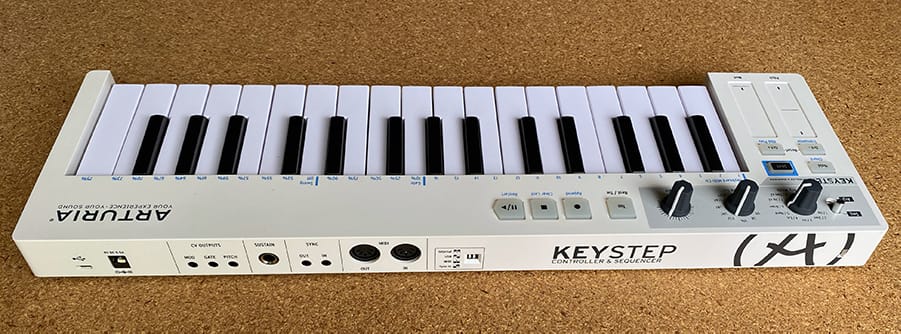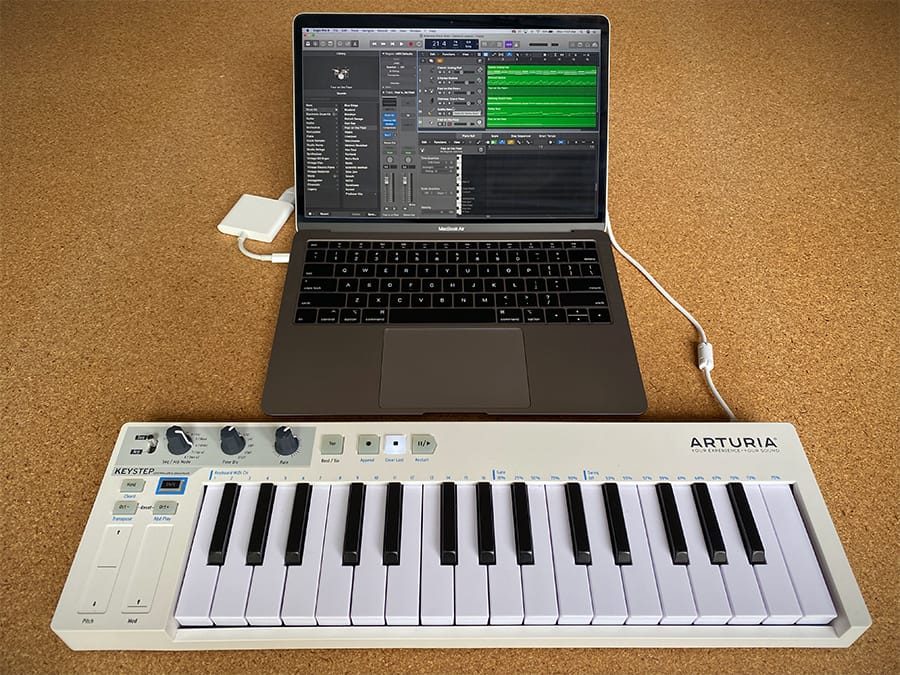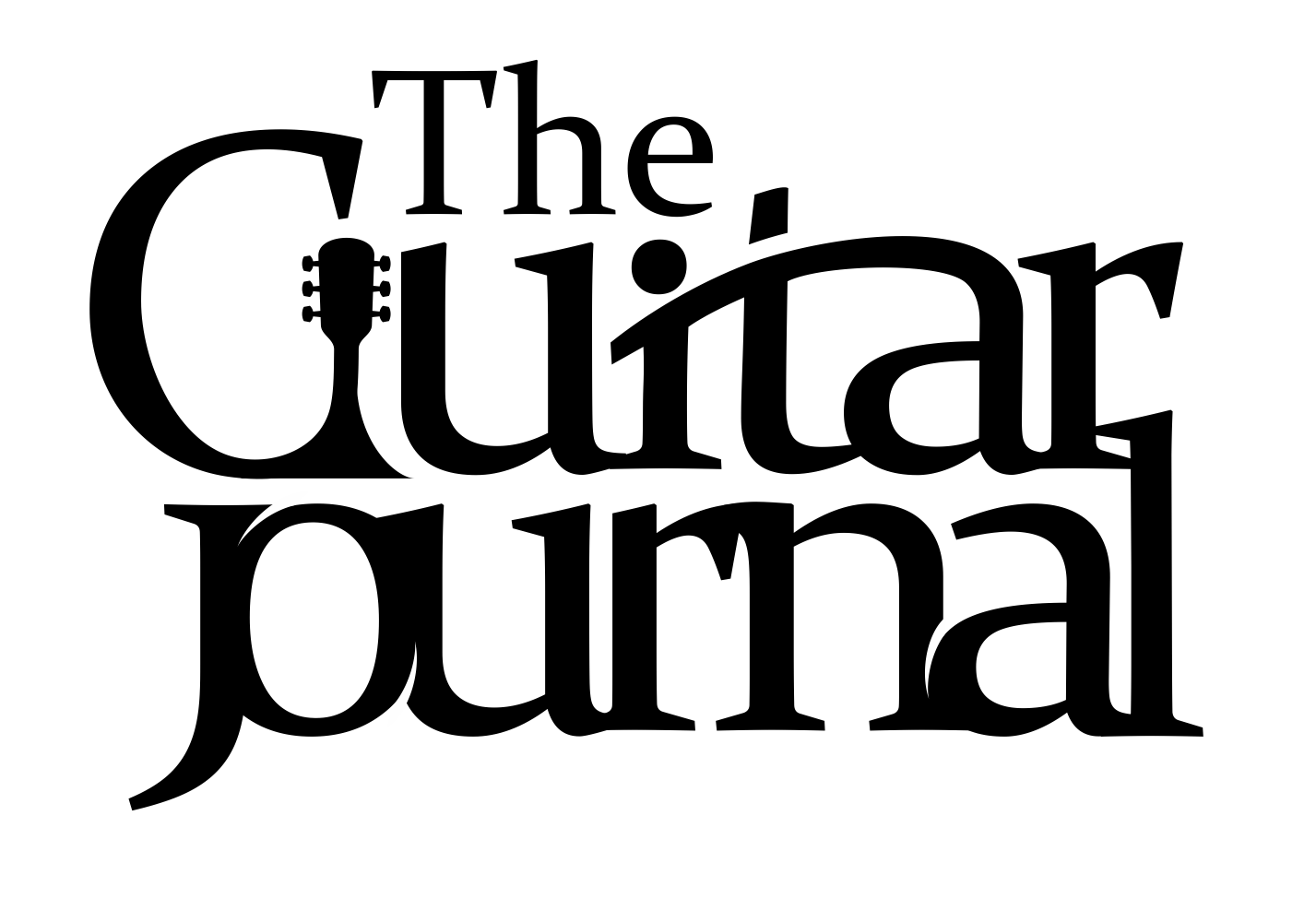Arturia Keystep - Ideal Guitar Sidekick
I’ve recently been trying out the Arturia Keystep portable USB MIDI controller. Here’s how I used it, and what worked.
I’ve recently been trying out the Arturia Keystep portable USB MIDI controller. Here’s how I used it, and what worked.
What is the Arturia Keystep?
The Arturia Keystep is a portable musical tool combining the functionalities of a keyboard controller with a polyphonic step sequencer to control both analog and digital devices.


Main Features
- USB MIDI connects to computers and our MCC editor
- Low power; can be powered by Apple iPad® (camera connection kit required)
- Arturia’s own Slimkey keybed with velocity and aftertouch
- Arpeggiator mode
- Sequencer mode
- Octave controls for keyboard and arpeggiator
- Chord play mode
- DC jack for standalone operation
- MIDI in/out ports
- Sync i/o ports
- Capacitive-touch pitch bend and mod wheels
- Full Feature List >>
In short, the Arturia Keystep is a nice "sidekick" for guitarists as they write, record, and perform.
Why is that?
Well, I work in Apple’s Logic Pro for writing and recording music. And the Logic Pro software is incredibly powerful and there’s a lot you can do with just a simple, single-channel audio interface and your guitar.
However (and this is a BIG 'however'!), Logic Pro and other DAWs are exponentially more powerful with even a simple USB-midi keyboard attached.
Here are three specific ways that the Arturia Keystep improved my guitar setup and writing process:
1. Fulfilling the “sidekick” role when 'demo'-ing tunes
As a guitarist, my writing and recording tend to be guitar-centric. But, just like in any good super hero movie, the hero never does it alone. You need a sidekick.
The original "ideal sidekick"...
Bass player
You can use the octave buttons to bring the keyboards range down several octaves. Then, with one hand, you can record in bass line parts. This was most effective when paired up with Logic to utilize the excellent bass batches built into Logic.
Keyboard pads
The 2.5 octaves on the Keystep are enough to get some good voicing for keyboard pads. Keyboard “pads” are those soft synth sounds that undergird much modern music.
Typically, they’re just a simple chord that is sustained under a strumming guitar, for example, to provide more depth and breadth in the music.
If you’re a guitarist, then you’re musical. And if you’re musical, then you can manage to figure out a few chord voicings on piano. Simple chord voicings sits nicely on the Arturia, allowing you to add some great synth pads to your guitar demos and songwriting exercises.
Lead lines
The size of the Arturia is ideal for a variety of lead lines. A synth lead line? A brass section punch? A cello melody? The Arturia, paired with a DAW like Logic Pro (with it’s multitude of virtual instrument), is ideal for entering these types of tracks into your mix.
2. Travel

The Arturia is short enough to fit in a medium to large backpack. It’s also powered from the USB, so you can get away with not even plugging in an external power cord. I tried this out, taking my MacBook Air, Arturia Keystep, and some basic Apple earbuds out of my studio space (unfortunately only up to my front porch - as I type this, it’s May 2020 and the coronavirus quarantine is still in effect where I live. So full travel testing will have to wait till later…).
It worked great for doing some basic songwriting and arranging. With the no other equipment (all on battery power), I was able to record this arrangement:
Theory study

Piano is an excellent way (I would say THE best way) for guitar players to learn music theory. Working out chord structure, harmony, scale patterns, etc. are all so much more visual on a piano.
The 2 1/2 octaves on the Arturia Keystep give you enough room to work out all of those things.
For example, I was recently checking out Frank Vignola’s Jazz Chord Colors course. In his course, Vignola builds up from simple to complex jazz chord voicings on the guitar. If you really want to understand how the chords are built, though, it's useful to actually lay them out on the keyboard. The Keystep worked well for doing this. For example, for seeing how the chord tones transitioned from a D7(#9)/A to a G6/9.
Note: For some advanced theory work, you may want the ability to visually cover 3-4 octaves. For this type of thing, I would prefer to use Arturia’s 88-key or 61-key models.
What it’s not great for:
Playing piano
The limited octaves and narrow keys mean that playing a traditional piano part is going to be uncomfortable at best, and unplayable at worst. Also, as a piano player, you will probably prefer a full keyboard with at least semi-weighted keys, to give a better “touch” to the instrument. (Again, the 88-key Arturia model would be better suited for this.)
Practicing scales
I had the idea that I could use it to practice some piano scales one hand at a time. Sort of a “travel piano” type of thing. The small key size, though, stopped me. The keys on the Arturia Keystep utilize a “slim key” action, which balances compact mini-key design with the playability of normal full-size keys. They work great for allowing the Keystep to slim down to a more compact, portable size. But for true piano practice, I don’t want to train my fingers’ muscle memory to think that the small size is normal.
Coming Soon:
Augmenting your guitar performance
While the Arturia key step is certainly a welcome addition to keyboardists ‘live’ rig, I think it could be equally welcome for lead guitar players.
Clarification: Guitar players are pretty well occupied with both hands needed on the guitar at all times. So, obviously, I don't propose playing both guitar and keys at once, but...
... there ARE scenarios where a lead guitar player may alternate between guitar lines and keyboard parts. In that case, this keyboard would probably work well on the stage in terms of economy of size, MIDI control capability, and ease of setup.
Unfortunately, with the coronavirus quarantine in effect here in Los Angeles, we’ll have to save that for a future ‘live’ test environment.
Perhaps we’ll take a look at the best ways for a guitarist to utilize a keyboard sidekick on stage in a coming article.
Where to buy the Arturia Keystep:
The Keystep is available in all the usual places, but if you want to go right to the source, you can order it direct from their website:

